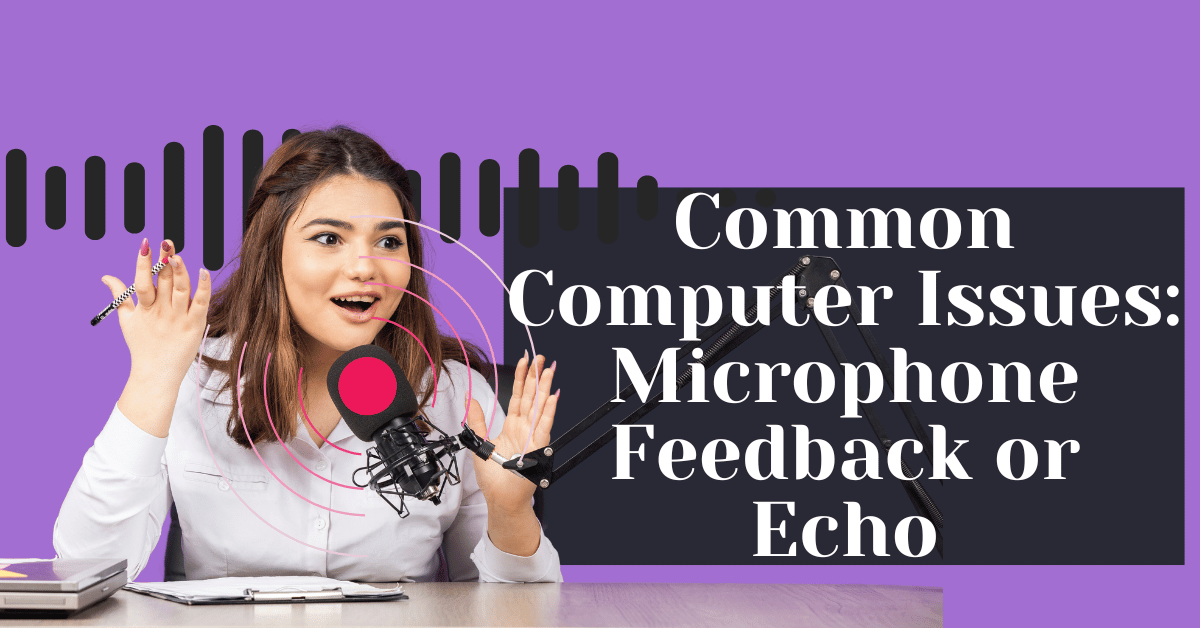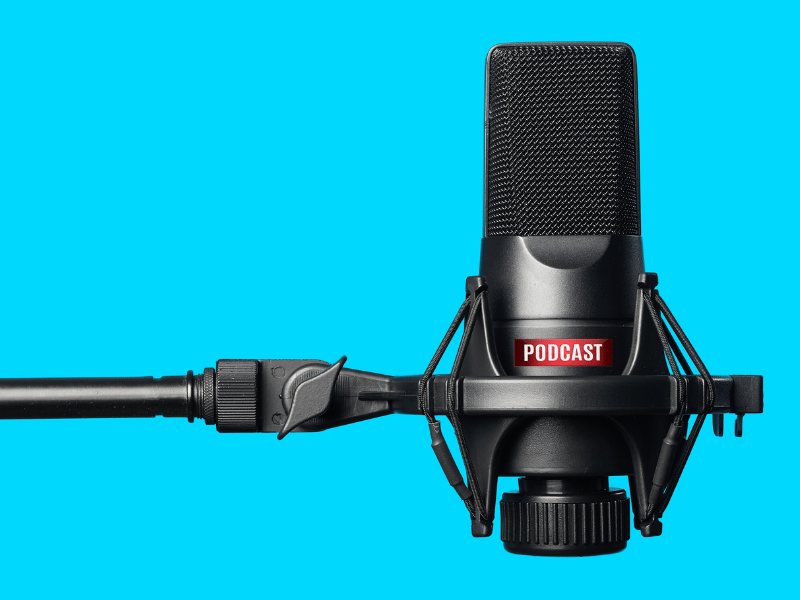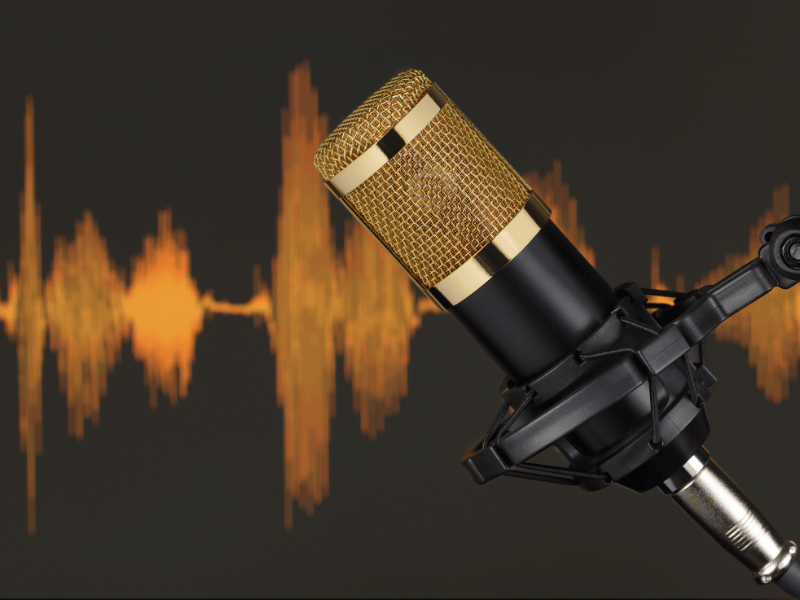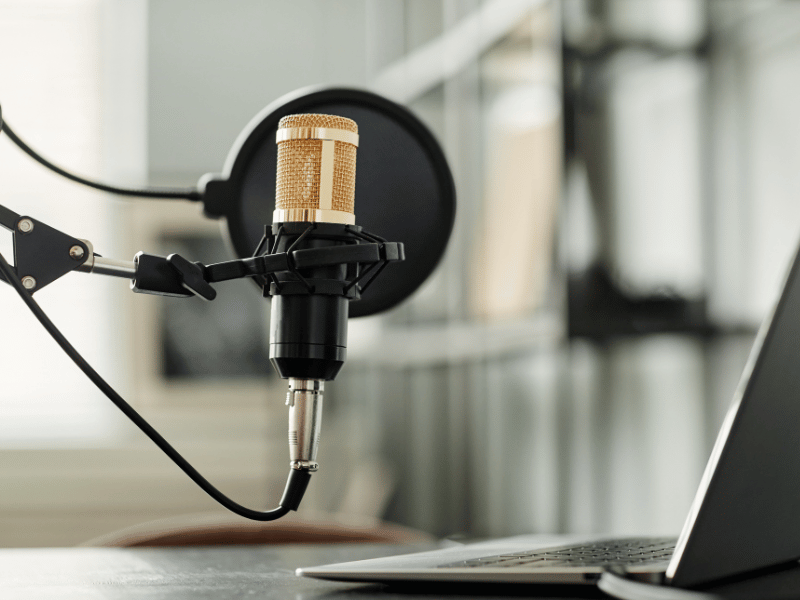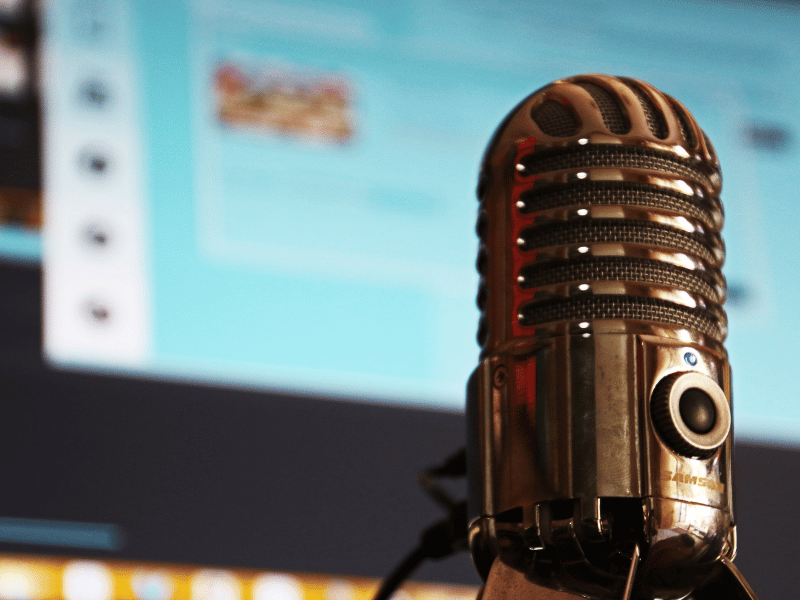Common Computer Issues: Microphone Feedback or Echo
Microphone feedback and echo are common computer issues that can disrupt online meetings, gaming sessions, and recording tasks. These issues not only affect the quality of audio but can also be frustrating for both the speaker and the listener. Understanding the root causes and finding effective solutions is crucial for anyone who regularly uses a microphone with their computer.
In this guide, we will delve into the common causes of microphone feedback and echo, provide practical solutions, and offer tips to prevent these issues from occurring. By the end of this article, you will have a thorough understanding of how to manage and mitigate microphone feedback and echo, ensuring clear and crisp audio in all your computer interactions.
Understanding Microphone Feedback or Echo
Microphone feedback occurs when the microphone picks up sound from the speakers and re-amplifies it, creating a loop that results in a high-pitched squeal or hum. This phenomenon is often experienced during live events or in situations where the microphone and speakers are too close to each other.
Echo, on the other hand, is a repetition of sound caused by sound waves reflecting off surfaces and being picked up by the microphone after a delay. This can happen in both online and offline settings, where the sound of the speaker’s voice is picked up again by their own microphone or by others on the call.
Both feedback and echo can significantly degrade audio quality, making it difficult for listeners to understand the speaker. They can also be disruptive and annoying, leading to a poor user experience.
What is Microphone Feedback?
Microphone feedback is a loop that occurs when sound from a speaker is picked up by a microphone, amplified, and then emitted again by the speaker. This loop continues until it creates a loud, high-pitched noise. Feedback can occur in various settings, from live performances to online meetings, and is often caused by improper equipment placement or settings.
What is Microphone Echo?
Microphone echo is a delay in the sound being picked up by the microphone and heard through the speakers or headphones. This delay can cause the sound to be repeated, creating an echo effect. Echoes are commonly encountered in online communications, where network latency and acoustic environments play a significant role.
Computer Repair and Services
Free estimate. Same-day services – Safemode Computer Service
Causes of Microphone Feedback and Echo
Understanding the causes of microphone feedback and echo is the first step in addressing these issues. Common causes include:
- Improper Microphone Placement: Placing the microphone too close to the speakers or at an incorrect angle can lead to feedback.
- High Microphone Sensitivity: Excessive sensitivity can cause the microphone to pick up ambient sounds and amplify them, leading to feedback or echo.
- Audio Loop: Incorrect audio routing can create loops, causing feedback.
- Poor Acoustic Environment: Hard, reflective surfaces can cause sound waves to bounce and create echoes.
- Software and Hardware Issues: Faulty drivers, outdated software, or incompatible hardware can contribute to feedback and echo.
- Network Latency in Online Calls: Slow internet connections can cause delays in audio transmission, leading to echo.
Common Causes of Microphone Feedback
Microphone feedback can be a persistent issue, especially in environments where audio equipment is used frequently. Understanding the common causes can help in addressing and preventing this annoying problem. Here, we will delve into three primary causes: improper microphone placement, high microphone sensitivity, and audio loops.
Improper Microphone Placement
Improper placement of microphones is one of the most common causes of feedback. When a microphone is placed too close to the speakers, it can pick up the sound emitted by the speakers, leading to a feedback loop. This can happen in various settings, from live performances to home office setups.
Tips for Proper Microphone Placement:
- Maintain Distance: Keep the microphone at a reasonable distance from the speakers. A good rule of thumb is to place the microphone at least one meter away from the speakers.
- Correct Angle: Position the microphone at an angle where it is less likely to pick up sound directly from the speakers.
- Use Directional Microphones: These microphones are designed to pick up sound from a specific direction, reducing the likelihood of feedback.
High Microphone Sensitivity
High microphone sensitivity can also contribute to feedback. When the sensitivity is set too high, the microphone can pick up ambient sounds and the sound from the speakers, which can then be re-amplified.
Adjusting Sensitivity Settings:
- Accessing Settings: Navigate to the sound settings on your computer or audio interface to adjust the microphone sensitivity.
- Recommended Levels: For most uses, setting the sensitivity to a medium level works best. You can fine-tune based on your specific environment.
- Testing: Regularly test the microphone setup to ensure that the sensitivity level is optimal.
Audio Loop
An audio loop occurs when sound is continuously fed back into the audio input, creating a loop. This can happen due to incorrect audio routing or when both the microphone and speakers are active simultaneously without proper isolation.
Preventing Audio Loops:
- Audio Routing: Ensure that your audio devices are correctly routed. Use dedicated audio software or interfaces to manage routing.
- Mute When Not Speaking: Mute the microphone when it is not in use to prevent accidental feedback.
- Use Headphones: Using headphones instead of speakers can help isolate the audio and prevent loops.
Common Causes of Microphone Echo
Microphone echo can be equally disruptive, often resulting from poor acoustic environments, software and hardware issues, and network latency during online calls. In this section, we will explore these causes in detail and provide practical solutions to mitigate them.
Poor Acoustic Environment
A poor acoustic environment is a significant contributor to microphone echo. Rooms with hard, reflective surfaces can cause sound waves to bounce around, leading to multiple echoes being picked up by the microphone.
Improving Room Acoustics:
- Add Soft Furnishings: Soft furnishings such as carpets, curtains, and upholstered furniture can absorb sound waves, reducing echo.
- Use Acoustic Panels: Installing acoustic panels on walls and ceilings can help control sound reflections. These panels are designed to absorb and diffuse sound, creating a more controlled acoustic environment.
- Room Layout: Consider the layout of your room. Positioning your workspace away from hard surfaces and corners can help minimize echoes.
Software and Hardware Issues
Software and hardware issues can also cause microphone echo. Outdated or incompatible drivers, faulty sound cards, and problematic software configurations can lead to poor audio quality and echo.
Updating or Reinstalling Drivers:
- How to Update Drivers: Regularly check for updates to your sound card drivers. You can do this through the device manager on your computer or by visiting the manufacturer’s website.
- Reinstalling Drivers: If updating doesn’t resolve the issue, try reinstalling the drivers. Uninstall the current driver through the device manager and then reinstall the latest version.
- Check Compatibility: Ensure that your audio hardware and software are compatible with each other and with your operating system.
Network Latency in Online Calls
Network latency can be a major cause of echo during online calls. Latency refers to the delay in audio transmission caused by slow internet connections or network congestion, which can result in echoes as the sound is received and then retransmitted after a delay.
Solutions for Reducing Latency:
- Improve Internet Speed: Use a high-speed internet connection to minimize latency. Wired connections are generally more stable and faster than wireless ones.
- Close Background Applications: Close any unnecessary applications or processes that might be consuming bandwidth.
- Use Quality-of-Service (QoS) Settings: Some routers have QoS settings that prioritize certain types of traffic, such as video and voice calls, to ensure a smoother experience.
How to Identify Microphone Feedback or Echo
Identifying whether you are experiencing microphone feedback or echo is crucial for finding the right solution. In this section, we’ll explore methods to test your microphone, recognize common symptoms, and differentiate between feedback and echo.
Testing Your Microphone
Regularly testing your microphone is an effective way to identify and troubleshoot audio issues. Several built-in tools and third-party software can help you diagnose problems.
Using Built-In Testing Tools
Most operating systems come with built-in tools to test your microphone. Here’s how you can use them:
Windows:
- Go to Settings > System > Sound.
- Under Input, select your microphone.
- Click on Device Properties and then on Test. Speak into your microphone to check the levels.
macOS:
- Go to System Preferences > Sound > Input.
- Select your microphone from the list.
- Speak into your microphone and observe the input level meter to ensure it’s picking up sound correctly.
Third-Party Software for Testing
If built-in tools are insufficient, several third-party applications can offer more advanced testing options:
- Audacity: This free, open-source software allows you to record and analyze audio in detail. You can visually inspect waveforms to detect feedback or echo.
- OBS Studio: Primarily used for streaming, OBS Studio also provides robust audio monitoring features that can help you identify issues.
Common Symptoms
Recognizing the symptoms of microphone feedback or echo can help you quickly diagnose and address the problem.
Feedback Symptoms
- High-Pitched Squeal: A constant, high-pitched noise often indicates feedback.
- Humming or Buzzing: Continuous low-frequency hums or buzzes can also be a sign of feedback.
- Sound Loop: If you hear a loop of your voice getting louder and more distorted, it’s likely feedback.
Echo Symptoms
- Delayed Repetition: Hearing your voice repeated after a short delay is a clear sign of echo.
- Multiple Voices: If your voice sounds doubled or if there are multiple overlapping voices, echo might be the cause.
- Reflective Sound: Sound bouncing back as if coming from a distant source usually points to echo.
Differentiating Feedback from Echo
While feedback and echo can both degrade audio quality, they have distinct characteristics:
Feedback: Typically involves a continuous noise that grows louder if not addressed. It’s often immediate and linked to equipment placement and settings.
Echo: Involves a delay between the original sound and the repeated sound. This delay can vary based on the environment and network conditions in online settings.
Solutions to Fix Microphone Feedback
Addressing microphone feedback effectively involves understanding its causes and implementing practical solutions. Here, we will cover three key strategies: adjusting microphone and speaker placement, changing sensitivity and volume settings, and using noise-canceling equipment.
Adjusting Microphone and Speaker Placement
Proper placement of your microphone and speakers can significantly reduce the chances of feedback. Here are some best practices:
Ideal Distances and Angles
- Maintain Distance: Keep the microphone at least one meter away from the speakers. This distance helps prevent the microphone from picking up sound directly from the speakers.
- Correct Angle: Position the microphone at an angle that minimizes its exposure to the direct sound from the speakers. This typically means pointing the microphone away from the speakers.
- Isolate Microphone: Use a microphone stand with a shock mount to reduce vibrations and physical noise transmission.
Tips for Different Environments
- Home Office: Place your speakers and microphone on separate desks if possible. This physical separation can help reduce feedback.
- Recording Studio: Use acoustic panels and soundproofing materials to control the environment and further reduce the chances of feedback.
- Live Events: Use directional microphones that pick up sound from a specific direction and place the speakers behind the microphone to prevent it from picking up amplified sound.
Changing Sensitivity and Volume Settings
Adjusting the sensitivity and volume settings of your microphone can also help mitigate feedback. Here’s how to do it:
Step-by-Step Guide for Different Operating Systems
Windows:
- Go to Settings > System > Sound.
- Under Input, select your microphone.
- Click on Device properties and adjust the volume slider to a lower level.
- Go to the Additional device properties and under the Levels tab, reduce the microphone sensitivity.
macOS:
- Go to System Preferences > Sound > Input.
- Select your microphone and adjust the input volume slider to reduce sensitivity.
Recommended Settings for Various Uses
- Online Meetings: Medium sensitivity to pick up clear speech without background noise.
- Recording: Low sensitivity to minimize ambient noise and ensure high-quality audio capture.
- Gaming: medium to high sensitivity, depending on the environment and the clarity needed.
Using Noise-Canceling Equipment
Noise-canceling equipment can be highly effective in reducing feedback. Here’s what you need to know:
Types of Noise-Canceling Microphones
- Active Noise-Canceling Microphones: These use built-in technology to detect and cancel out background noise.
- Passive Noise-Canceling Microphones: These rely on physical barriers, such as foam or other materials, to block out noise.
Benefits and Drawbacks
Benefits:
- Significant reduction in background noise and feedback.
- Improved audio clarity and quality.
Drawbacks:
- Can be more expensive than standard microphones.
- May require additional power sources or batteries for active noise-canceling models.
How Safemode Computer Service Can Help Address the Issue
If you’re experiencing persistent microphone feedback or echo, seeking professional assistance can be highly beneficial. Safemode Computer Service offers comprehensive solutions to address these common computer issues. Here’s how they can help:
Expert Diagnosis
Safemode Computer Service provides expert diagnosis to pinpoint the exact cause of your microphone issues. Their technicians have the skills and tools to identify whether the problem is due to hardware, software, or environmental factors.
Services Offered:
- Thorough System Check: A complete examination of your computer’s audio system to identify the root cause of feedback or echo.
- Environmental Assessment: An analysis of your room’s acoustics and setup to recommend improvements that can reduce echo and feedback.
Customized Solutions
After diagnosing the issue, Safemode Computer Service offers tailored solutions to fix and prevent future occurrences. Their approach is customized to meet your specific needs, ensuring optimal audio performance.
Conclusion
Safemode Computer Service offers a comprehensive range of services to address microphone feedback and echo issues. From expert diagnosis to customized solutions and professional installation, their team ensures that your audio setup is optimized for the best performance. With ongoing support and maintenance, you can enjoy clear and high-quality audio for all your needs.
